This Cajun Spiced Roasted turkey recipe comes straight from my Southern Louisiana roots, where well-seasoned food is a must. With 10 years of sharing my Southern recipes, I can promise you this turkey will be the star of your holiday table. Bold seasoning is never optional that's why I use a dry rub brine for crispy skin with a spicy kick! You can also inject the turkey with butter and herbs to keep the bird tender, moist, and loaded with flavor.
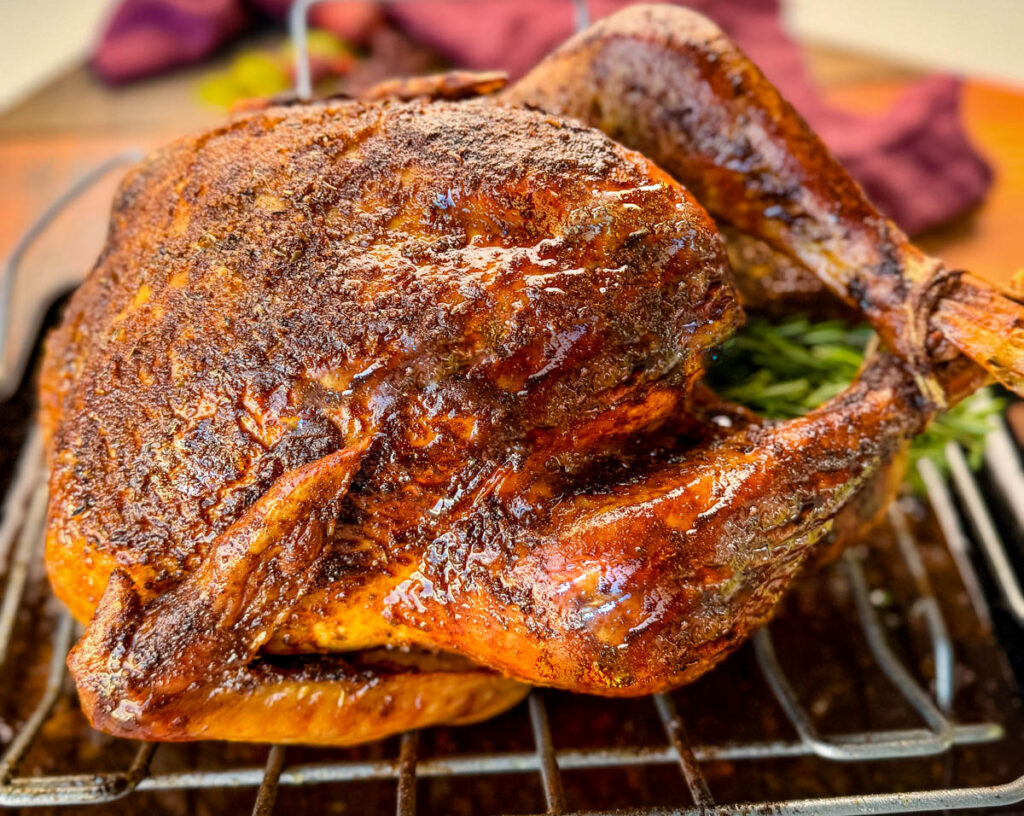
Want to save this recipe for later?
This post contains affiliate links. Please read my full disclosure here.
Thanksgiving turkey gets a bad rep. To be honest, rightfully so! Sometimes I've shown up for the holiday meal and the turkey was bland and way too dry! Luckily there are methods to combat both of these.
This one is served using a dry Cajun rub. If you aren't a fan of spicy, try using a Creole seasoning or whatever you love to use to season poultry.
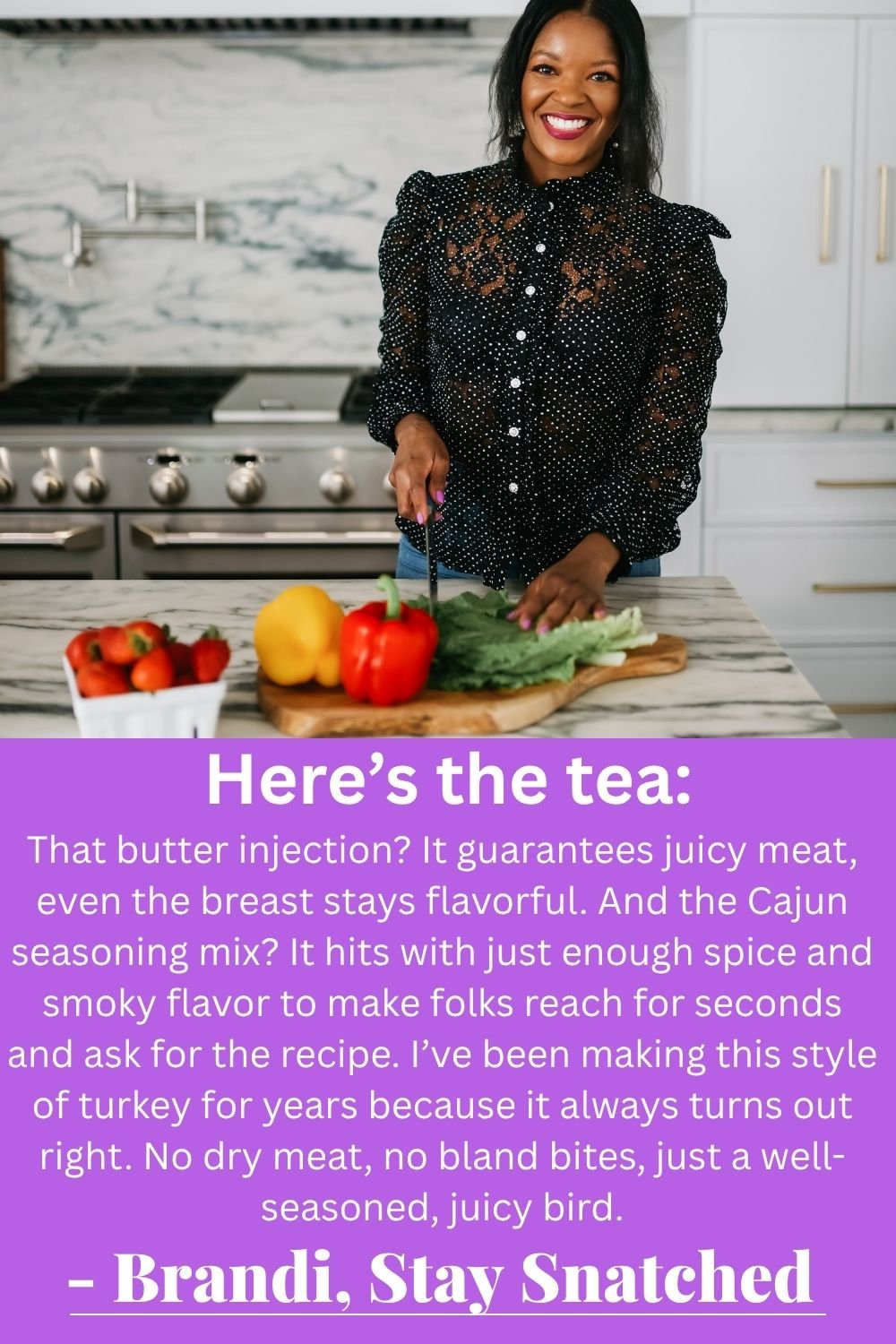
Cajun Turkey Ingredients
- Turkey: A fresh for frozen turkey will work.
- Cajun Seasoning: Here's where the flavor come in.
- Olive Oil: Helps the seasoning stick and gives the skin a golden, crispy finish.
- Butter Injection Marinade (Optional): Adds rich, buttery moisture straight into the meat so it stays juicy, even the white meat. Trust me, you don't want to skip this!
- Broth or Water: Helps keep the turkey moist while it roasts and makes a flavorful base for pan drippings or gravy.
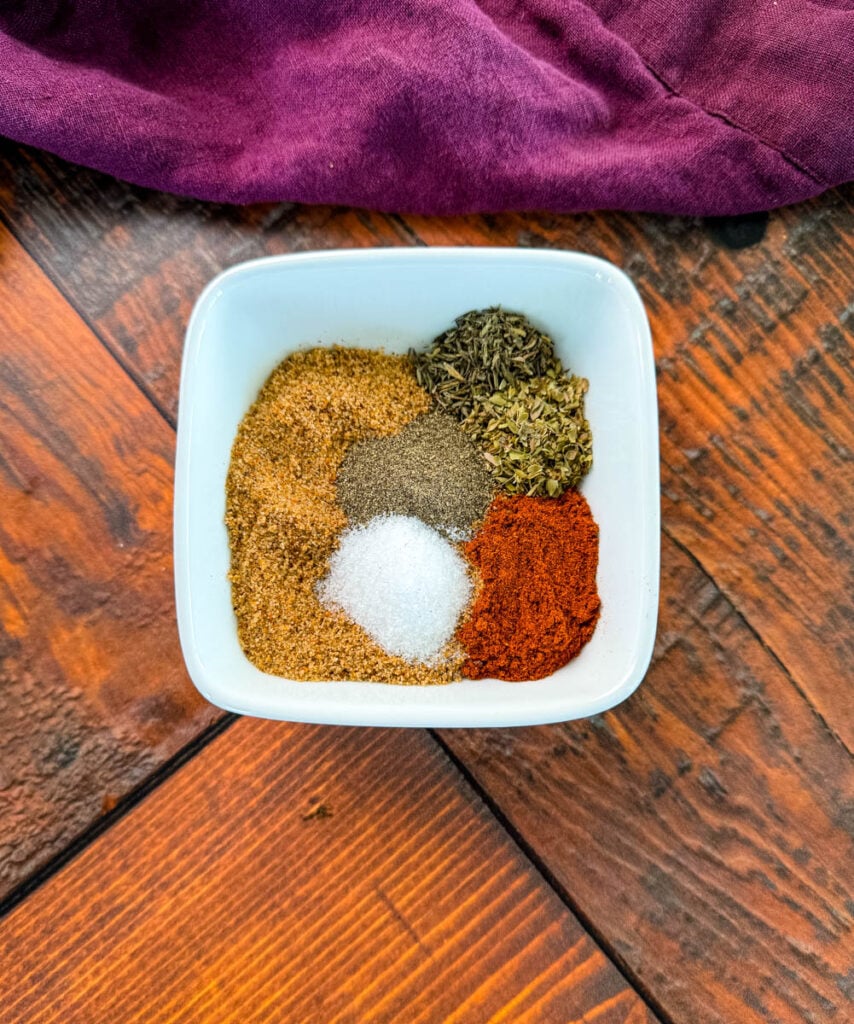
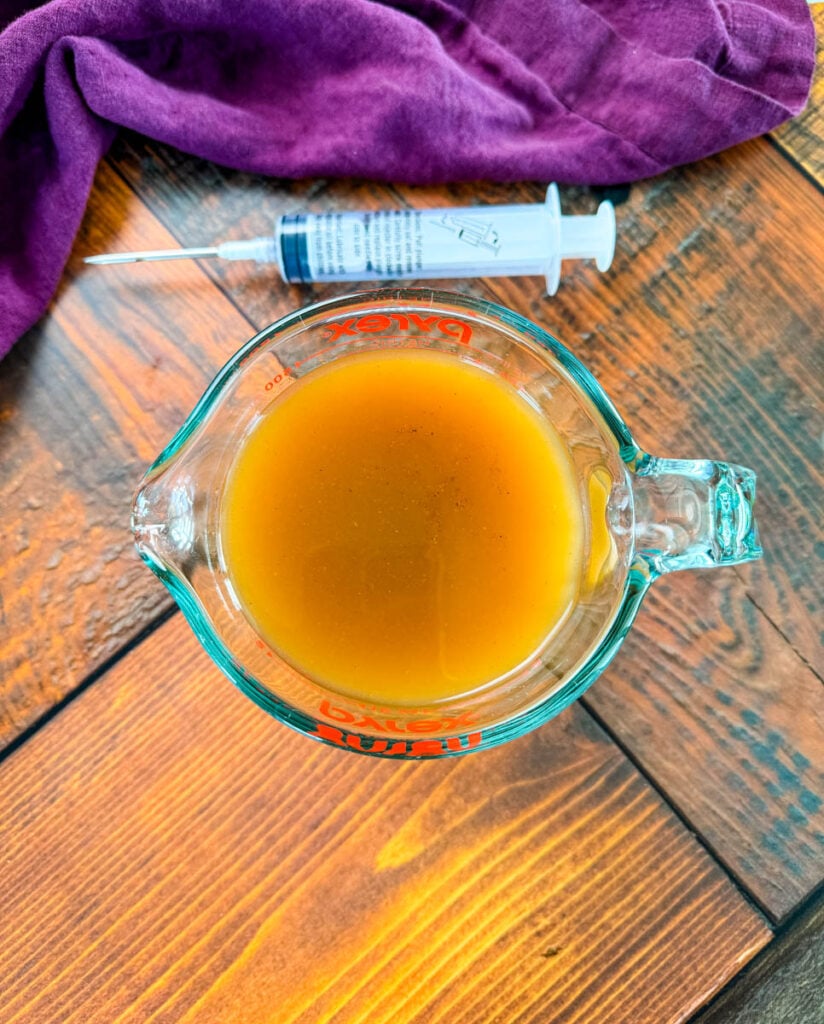
Equipment/Tools/Pan You Will Need
You will want to use a roaster, and be sure to check the size to ensure it will fit your turkey and the dimensions of your oven.
Here are great guidelines on How to Choose the Right Size Roasting Pan You Need here.
| Turkey Size | Minimum Roasting Pan Size |
|---|---|
| Up to 12 pounds | 14 x 10 x 2-¾ inches |
| Up to 16 pounds | 15-¾ x 12 x 3 inches |
| Up to 20 pounds | 16 x 13 x 3 inches |
How to Thaw a Turkey
I recommend thawing in the refrigerator or in cold water.
If using the refrigerator, keep the turkey in it's original packaging and place a sheet pan underneath to catch any juices that may leak out.
Here is the safety chart for thawing in the fridge or in cold water according to the USDA:
4-12 pounds: 1 to 3 days
12-16 pounds: 3 to 4 days
16-20 pounds 4 to 5 days
20-24 pounds 5 to 6 days
Here is the safety chart for thawing in cold water according to the USDA:
4-12 pounds: 2 to 6 hours
12-16 pounds: 6 to 8 hours
16-20 pounds 8 to 10 hours
20-24 pounds 10 to 12 hours
Once thawed, it can stay in the fridge, safely, up to 2 days.
How to Make Cajun Turkey
Detailed measurements and full instructions can be found in the recipe card at the bottom of this post.
- Prep the turkey: Make sure your whole turkey is fully thawed. Remove the giblets and neck from the cavity. Pat the turkey dry with paper towels, this helps the skin crisp up.
- Inject the flavor: Using an injector, pump the butter marinade into the thickest parts of the turkey: breasts, thighs, and drumsticks. This helps lock in moisture and flavor from the inside out.
- Make the seasoning blend: In a small bowl, mix together Cajun seasoning, smoked paprika, black pepper, salt, ground thyme, and oregano. This blend is going to give the skin that bold, spicy flavor.
- Season the outside: Rub olive oil all over the outside of the turkey or use olive oil spray if that’s easier. Then sprinkle the seasoning mix generously all over the skin, making sure you coat every inch.
- Add moisture to the pan: Pour the chicken or turkey broth into the bottom of your roasting pan. This keeps the bird juicy while it cooks and gives you some flavorful drippings for gravy.
- Crisp: Place the turkey in the oven for 30 minutes on 425 degrees. After 30 minutes adjust the temperature to 325 degrees. This will crisp the skin. If you don't want crispy skin you can start it at 325 degrees.
- Tent with foil: Loosely cover the turkey with foil. This helps it cook evenly and keeps the seasoning from burning early on.
- Roast: Roast the turkey at 325 degrees. Cook time will depend on the size of your bird.
- Check doneness: Use a meat thermometer to make sure the thickest part of the thigh reaches 165°F.
- Rest before carving: Let the turkey rest, loosely tented with foil, for at least 20–30 minutes before carving. This helps the juices redistribute so every bite stays juicy.
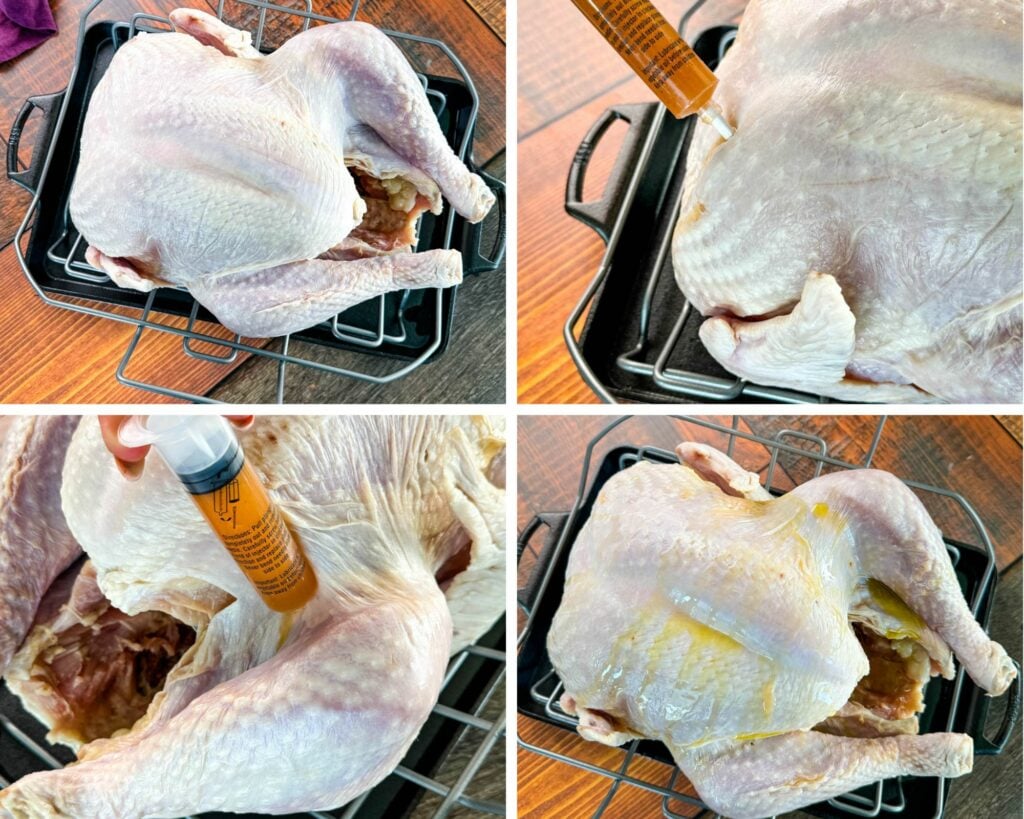
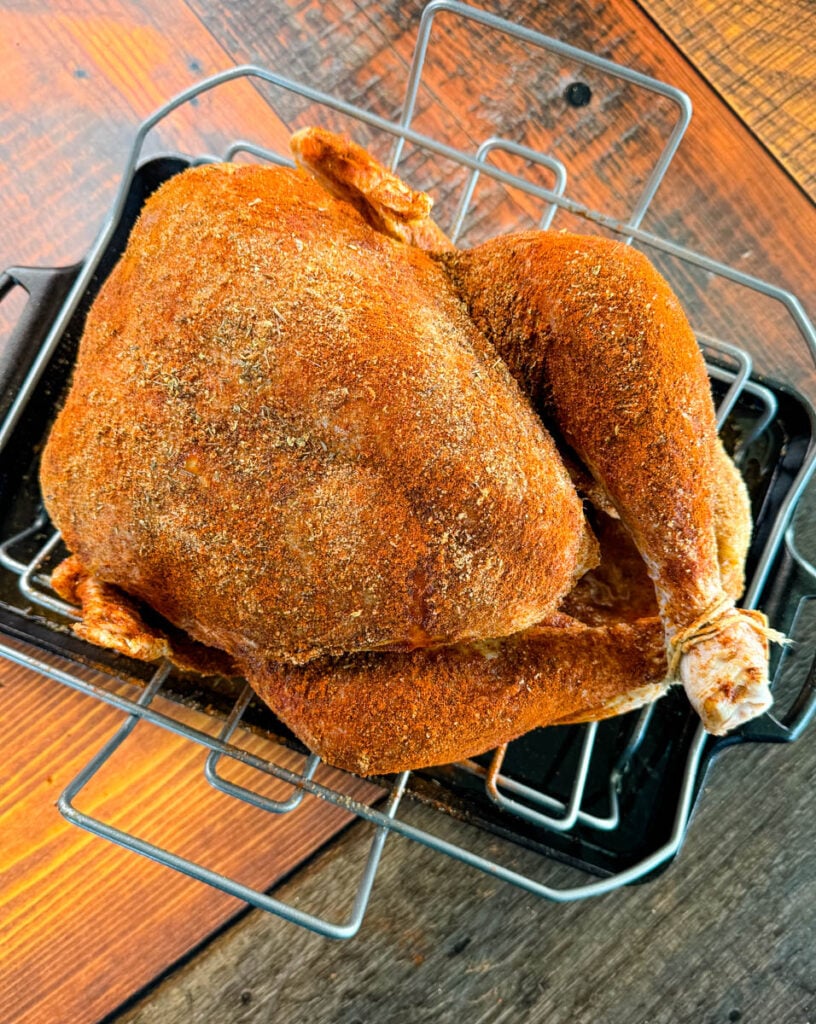
The Best Way to Season Cajun Turkey
You will need to remove the contents of the inner cavity. Giblets are typically inside. Giblets are the little bundle of parts and usually includes the neck, the gizzard, which is a muscle that grinds up food before it enters the digestive system, the heart, and the liver.
Some people save these and cook them up or make gravy. You can discard if you wish.
Dry the turkey with paper towels. I like the spritz the turkey with olive oil using this spray bottle from Amazon. This will allows the spices to adhere. You can also drizzle it on and rub it in.
If you are injecting the bird with butter, you don't need a ton of olive oil, unless you want it! Getting the skin nice and moist with oil will help produce crispy skin on the turkey.
Then add your spices. I use the following:
- Cajun Seasoning
- Dried or Ground Thyme
- Dried or Ground Oregano
- Paprika (I prefer Smoked Paprika)
- Salt and Pepper
Once you have your olive oil on the skin, combine your spices and rub them in all over the bird front and back.
Next, I inject the turkey. I like to use a combination of Tony Chachere's Butter Injection Marinade and Tony Chachere's Garlic and Herb Injection Marinade. I like to use both of them because I like the combination of the butter and herbs for flavor. The butter is necessary if you don't want a dry turkey.
Their kit comes with an injector that you press right into the bird. Per the instructions, you should inject 1 ounce of the marinade per pound of turkey you have. This turkey was 12 pounds so I used 6 ounces of the butter and 6 ounces of the garlic and herb marinade. You don't have to combine two. You can do whatever you wish.
To create your own injection, add 2 tablespoons of melted butter to broth. The amount of broth you will need is 1 ounce per pounds of turkey. From there, you can add whatever seasoning and spices you wish. You can use this injector from Amazon.
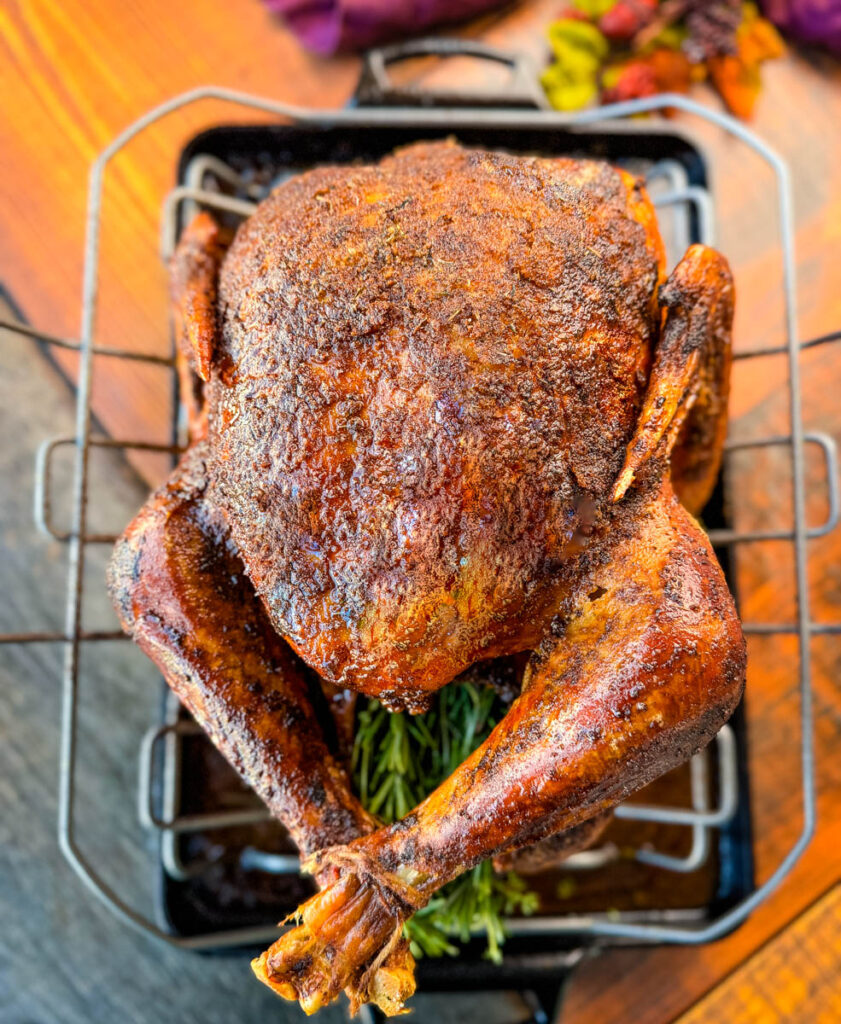
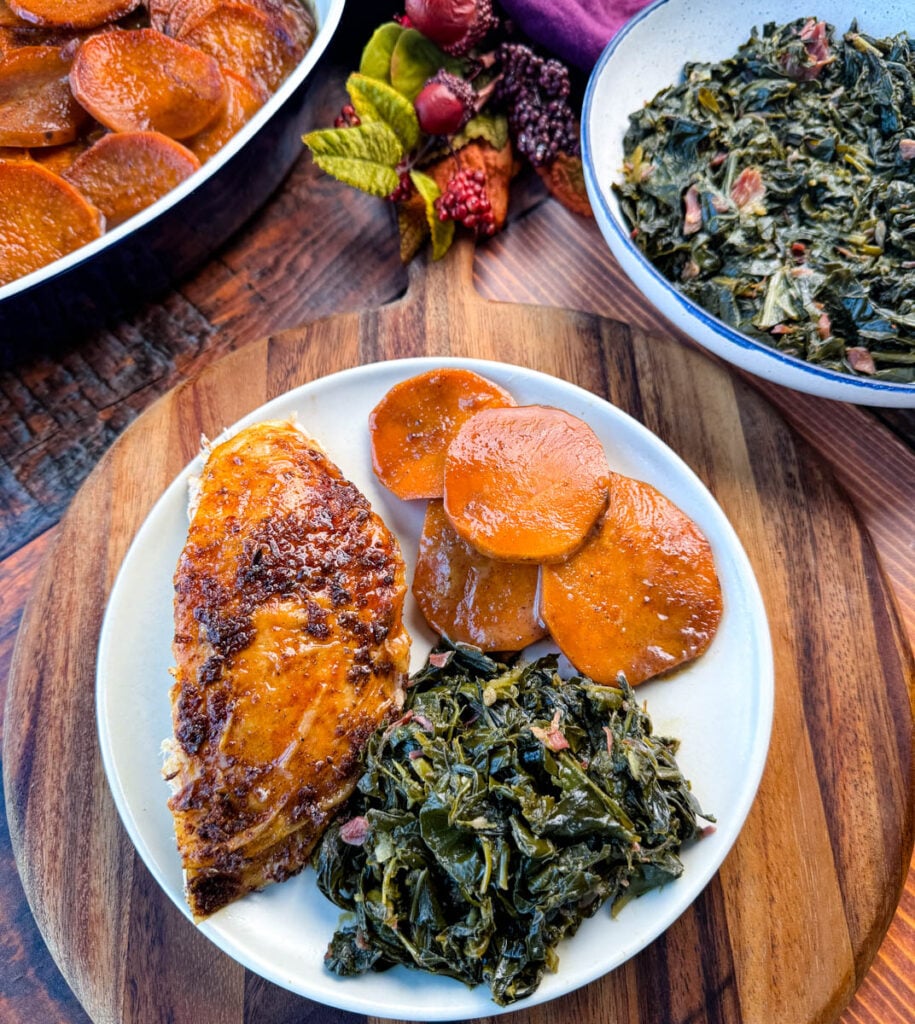
How to Prevent Dry Turkey/ Prevent it From Drying Out
A few things can lead to a dry turkey. One cause is constant basting. It sounds like that should help, right? If you're constantly opening the oven door to baste the turkey, you are letting heat out the oven. This means you will need to cook it longer, which will dry it out.
If you inject the turkey with a marinade prepared with something like butter, this helps add moisture directly to the bird. Some people like to stuff butter directly under the skin of the turkey. If you use an injector, you don't need to. You can read more about How to Put Butter Under Turkey Skin here.
Sometimes turkeys are dry because they are huge. It's really difficult to cook a 20+ pound turkey evenly where the entire turkey cooks at the same speed. If you have a huge turkey, some parts may turn out drier than others.
Carving the turkey BEFORE you cook it is another solution to ensure the entire bird cooks at the same speed and temperature.
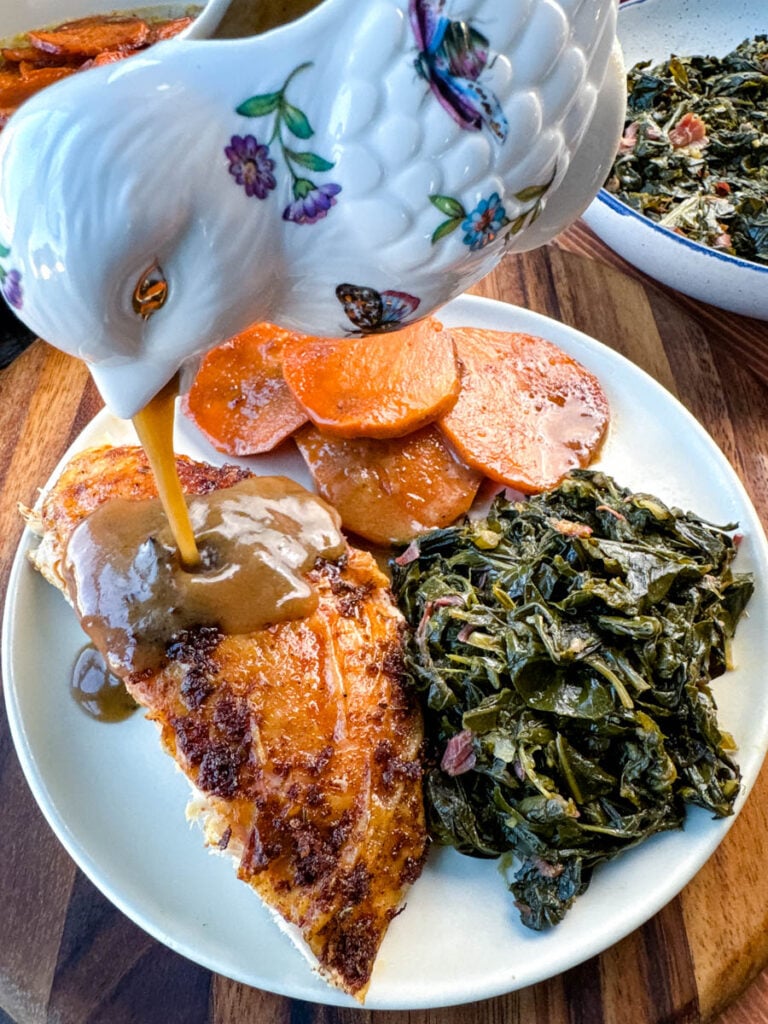
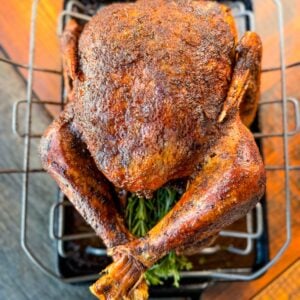
Cajun Turkey Recipe
Want to save this recipe for later?
Equipment
Ingredients
- 10-14 pound whole turkey
- Injectable Butter Marinade You will need 1 ounce per pound of turkey. See notes for information on what I used.
- 1 ½ cups turkey or chicken broth You will likely need an additional 1-2 cups of broth if the initial broth completely dissolves.
- ½ cup olive oil Or olive oil spray. I use a lot less by using oil I've added to a bottle.
- ½ teaspoon dried or ground oregano
- ½ teaspoon dried or ground thyme
- 3 tablespoons Cajun Seasoning
- 1 teaspoon paprika I used Smoked Paprika
- ½ teaspoon ground black pepper
- 1 teaspoon salt
- foil
Instructions
- Preheat oven to 425 degrees.
- Pat turkey dry. Remove all of the contents from the inner cavity.
- Pour the broth into the bottom of a roasting pan and place the turkey on top.
- Inject the turkey with the marinade. Focus on areas throughout the entire turkey, the breasts, legs, etc.
- Drizzle the turkey with olive oil or I like to use this oil spray bottle that I load with olive oil. It makes it easier to coat the turkey by spraying it on and you will likely use less oil since it's also injected with butter.
- Season the entire turkey and rub the spices into the skin.
- Place the turkey in the oven for 30 minutes on 425 degrees. After 30 minutes adjust the temperature to 325 degrees. This will crisp the skin. If you don't want crispy skin you can start it at 325 degrees.
- If you notice the turkey is starting to brown quickly (usually the legs for sure), place a piece of foil over the turkey to tent excess heat. You don't want to wrap it. Place it on top.
- Turkey will take 2-5 hours (depending on size) to cook based on the size. You will need to use a meat thermometer to test. If you notice that the broth is low, top it off with more.
- Check if the turkey has finished cooking by using a meat thermometer. You always want to test the thickest part of the turkey, which is typically between the thigh and leg. Ensure it reaches an internal temperature of at least 165 degrees. I usually test several areas of the turkey to be sure.
- Allow the turkey to rest for a minimum of 20 minutes prior to slicing to allow the juicies to settle. If you slice too soon it will result in dry turkey.
- Keep the turkey drippings if you plan to make gravy. I combine it with a tablespoon of butter and then start with a tablespoon of flour and add more if necessary to thicken.
Notes
- 1 tablespoon paprika (I prefer smoked)
- ½ tablespoon garlic powder
- ¼ tablespoon ground black pepper
- ¼ tablespoon ground white pepper
- ¼ tablespoon onion powder
- ¼ tablespoon ground oregano
- ¼ tablespoon red cayenne pepper
- 2 teaspoons ground thyme
Nutrition
Nutrition Data
Macros are provided as a courtesy and should not be construed as a guarantee. This information is calculated using MyFitnessPal.com. To obtain the most accurate nutritional information in a given recipe, you should calculate the nutritional information with the actual ingredients used in your recipe, using your preferred nutrition calculator. You are solely responsible for ensuring that any nutritional information provided is accurate, complete, and useful.
How to Make Homemade Cajun Seasoning
You can make your own Cajun Seasoning using the following:
- 1 tablespoon paprika (I prefer smoked)
- ½ tablespoon garlic powder
- ¼ tablespoon ground black pepper
- ¼ tablespoon ground white pepper
- ¼ tablespoon onion powder
- ¼ tablespoon ground oregano
- ¼ tablespoon red cayenne pepper
- 2 teaspoons ground thyme
Frequently Asked Questions and Thanksgiving Turkey Tips
Cajun Seasoning is often spicy with an emphasis on peppers, white pepper, black peppers, cayenne pepper, and bell peppers. It also has hints of paprika and garlic.
If you are looking for an option that's less spicy Creole Seasoning may work better for you than Cajun.
Creole Seasoning has more emphasis on herbs such as basil, oregano and thyme. It is milder than Cajun Seasoning. If you want to substitute Creole Seasoning, and you still want the added heat, add in a teaspoon or more of red cayenne pepper.
You will also love our Cajun Chicken and Sausage Skillet, Cajun Shrimp Pasta, Cajun Dirty Rice
Smothered Okra, and Cajun New Orleans Shrimp and Grits.
The general rule of thumb is 1 pound of turkey per guest. If you have a small party you can even consider a turkey breast. This recipe breaks down the ingredient servings based on the size and weight of the turkey, 12 pounds in this case.
That will make it easy to scale down or scale up the servings you will need of each ingredient, by taking into account the weight of the turkey you are using.
I say no. The stuffing will usually cook a lot faster and will end up overcooked before it's said and done. If you add it after you have started the roasting process, you will probably end up with a dry turkey. I recommend pairing this with my dressing recipe noted below.
Let the turkey rest before slicing for 20 minutes to allow juices to set. The turkey will carve more easily. You will also wind up with dry turkey if you slice too soon.
Reheat on 325 degrees in the oven until warm. You can also place it in broth to keep it juicy while it bakes.
After the turkey is drizzled in oil and seasoned, place it in the oven on 425 degrees for 30 minutes. You will lower the heat afterward, but this gets the skin crisp.
The total time to cook will vary based on the size of your turkey. This 12 pound bird took close to 3 hours. You will need to use a meat thermometer for accuracy. It will need to reach an internal temperature of 165 degrees. A whole turkey is safe when cooked to a minimum internal temperature of 165 degrees.
Check the internal temperature in the innermost part of the thigh and wing and the thickest part of the breast.
According to the USDA's Food Safety Guidelines, here are example timetables for roasting. You will still need to use a meat thermometer to avoid slicing into a turkey that isn't done.
8 -12 pounds 2½ to 3½ hours
12-14 pounds 3 to 3¾ hours
14-18 pounds 3¾ to 4¼ hours
18-20 pounds 4¼ to 4½ hours
20-24 pounds 4½ to 5 hours
More Thanksgiving Main Dishes
Baked Turkey Wings
Traeger Smoked Turkey
Smothered Turkey Wings
Southern Baked Ham With Pineapple
Air Fryer Turkey Wings
Air Fryer Turkey Legs
Crockpot Turkey Breast Recipe
Stuffed Turkey Legs
Slow Cooker Turkey Legs
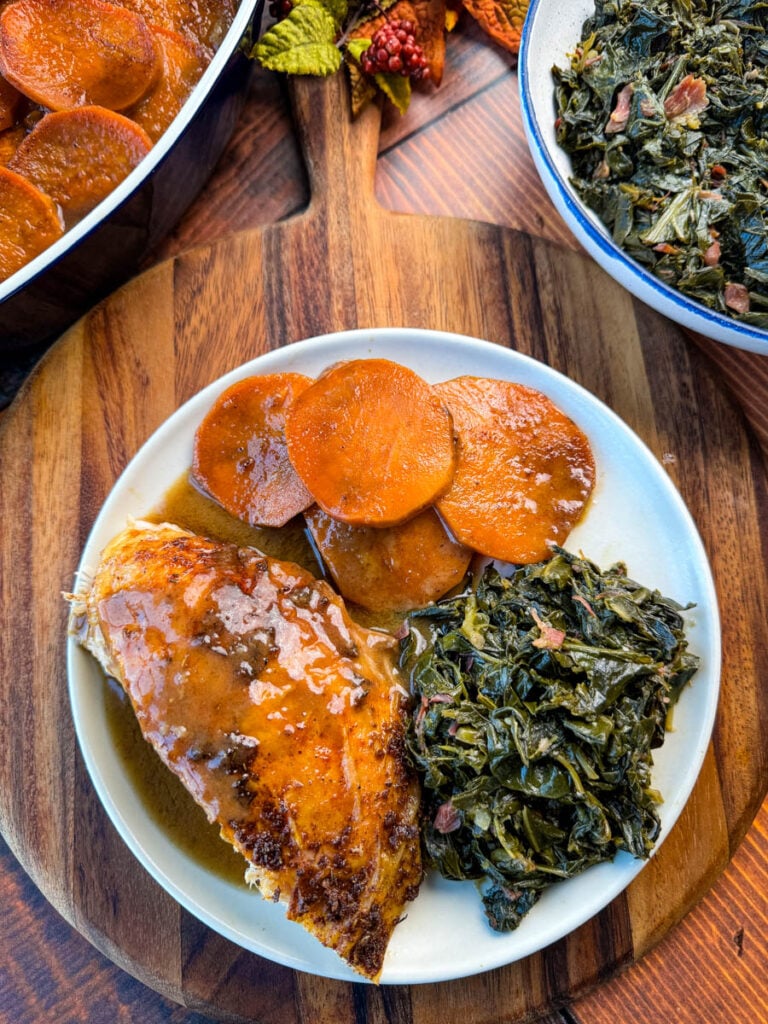
Thanksgiving Side Dishes to Pair with Turkey
Southern Mac and Cheese Recipe
Southern Mustard Greens
Chicken and Cornbread Dressing
Southern Cornbread Recipe
Southern Creamed Corn
Southern Cooked Cabbage
Southern Black Eyed Peas
Leftover Turkey Recipes
Leftover Turkey Rice Soup
Leftover Turkey Chili
Leftover Turkey Nachos
Turkey and Cheese Sliders
Check out a full list of Soul Food Thanksgiving Recipes here. Pair these with our Turkey Graving From Drippings recipe. Watch step by step video instructions on how to make this recipe on Youtube.
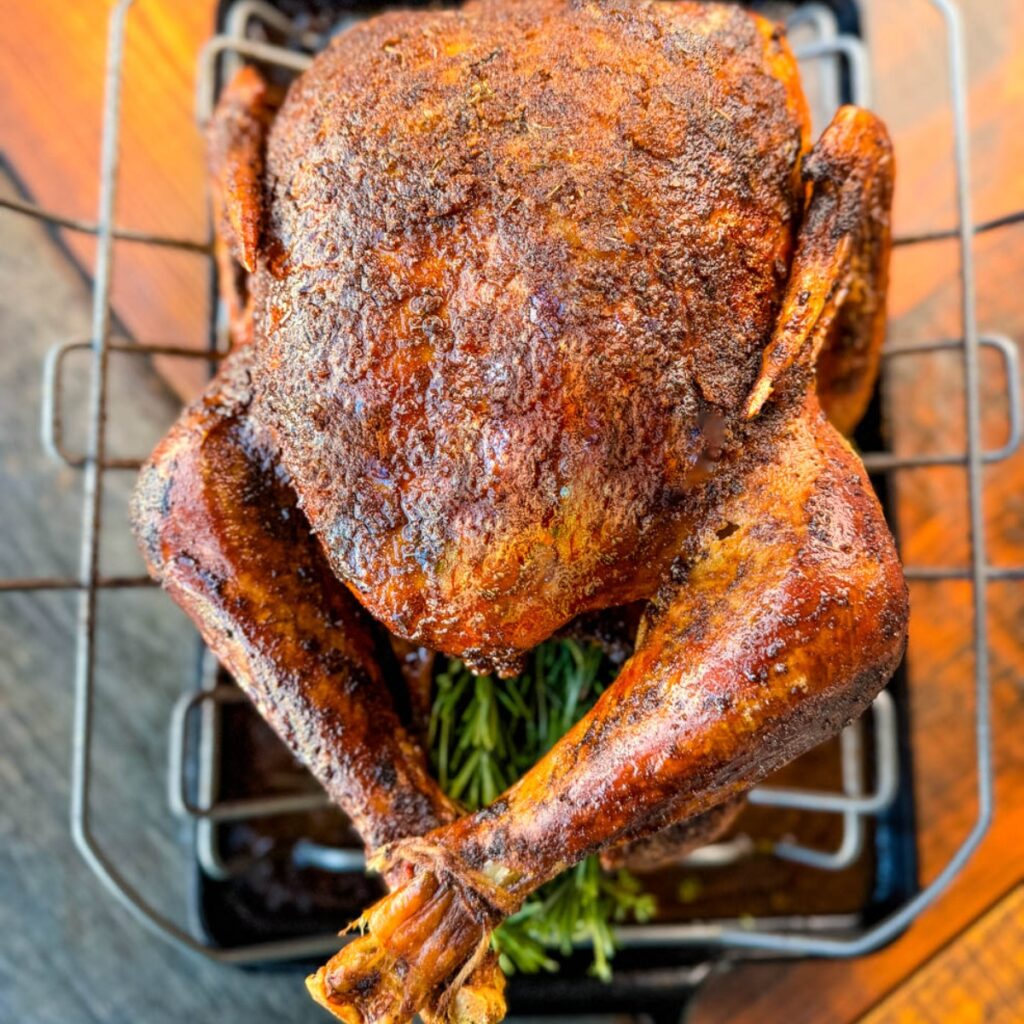

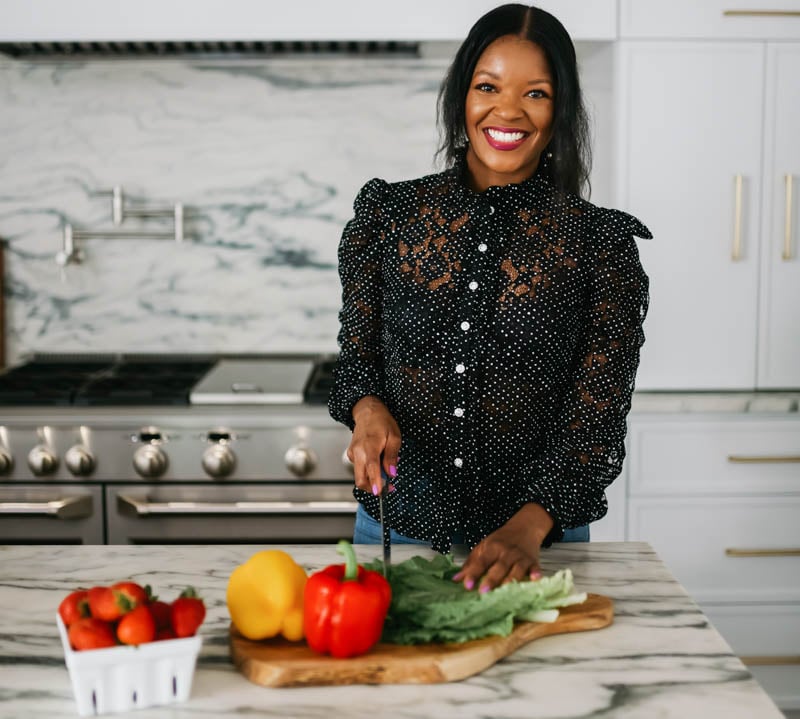
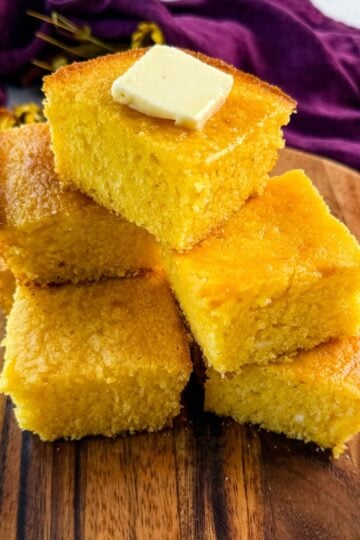
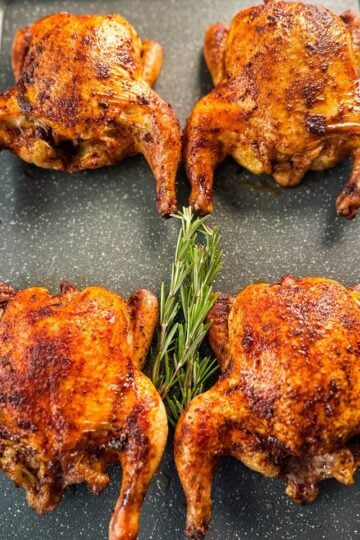
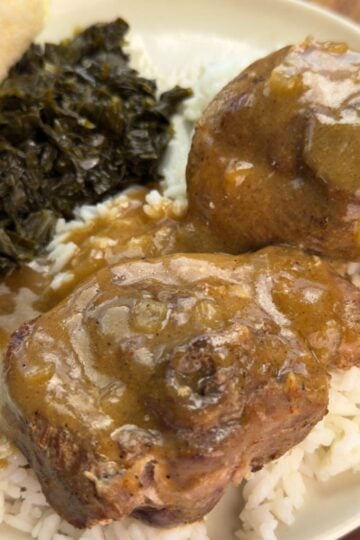
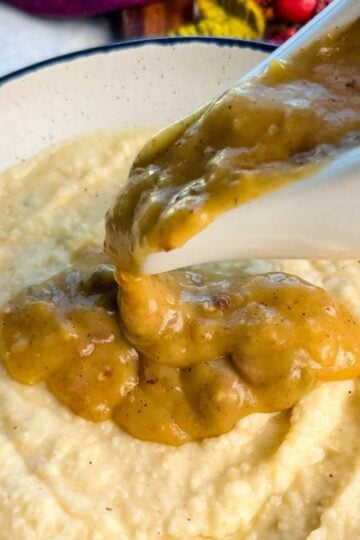
Leave a Reply